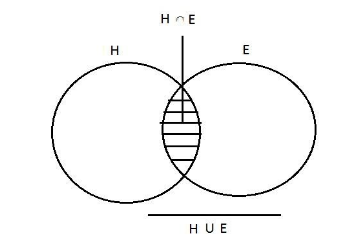
In a group of \[{\mathbf{45}}\] students, \[{\mathbf{22}}\] can speak Hindi only, \[{\mathbf{12}}\] can speak English only. How many can speak both Hindi and English?
Answer
573.3k+ views
Hint: In the given question we have to find out the number of students speaking both Hindi and English. To solve this question let us consider the number of students speaking Hindi is $(22 + x)$ as no. of people speaking both are also included in people of speak Hindi whereas the number of students speaking English is $\left( {12 + x} \right)$ as no. of people speaking both are also included in people of speak English . Use the relation $n\left( {A \cup B} \right) = n\left( A \right) + n\left( B \right) - n\left( {A \cap B} \right)$ and work out the value of to get the answer. This question can be solved using the Venn diagram.
Complete step-by-step answer:

Let, number of students speaking English is $\left( {12 + x} \right)$
i.e. $n\left( E \right) = 12 + x$
& let, number of students speaking Hindi is \[\left( {22 + x} \right)\]
i.e. \[n(H) = 22 + x\]
Where \[x\] are the number of students who can speak both English and Hindi
Since, total no. of students are \[45\]
i.e. \[n\left( {A \cup B} \right) = 45\]
We know the relation –
\[{
n\left( {A \cup B} \right) = n\left( A \right) + n\left( B \right) - n\left( {A \cap B} \right) \\
here, \\
n\left( {H \cup E} \right) = n\left( H \right) + n\left( E \right) - n\left( {H \cap E} \right) \\
\Rightarrow 45 = 22 + x + 12 + x - x \\
\Rightarrow 45 = 34 + x \\
\Rightarrow x = 11 \\
} \]
\[\therefore 11\] students can speak both English and Hindi.
Note: The asked question was related to set theory. This question can be solved by using the Venn Diagram. Set theory is the collection of sets on objects. Questions related to them can be solved by using Venn diagrams or set theory approach.
Complete step-by-step answer:

Let, number of students speaking English is $\left( {12 + x} \right)$
i.e. $n\left( E \right) = 12 + x$
& let, number of students speaking Hindi is \[\left( {22 + x} \right)\]
i.e. \[n(H) = 22 + x\]
Where \[x\] are the number of students who can speak both English and Hindi
Since, total no. of students are \[45\]
i.e. \[n\left( {A \cup B} \right) = 45\]
We know the relation –
\[{
n\left( {A \cup B} \right) = n\left( A \right) + n\left( B \right) - n\left( {A \cap B} \right) \\
here, \\
n\left( {H \cup E} \right) = n\left( H \right) + n\left( E \right) - n\left( {H \cap E} \right) \\
\Rightarrow 45 = 22 + x + 12 + x - x \\
\Rightarrow 45 = 34 + x \\
\Rightarrow x = 11 \\
} \]
\[\therefore 11\] students can speak both English and Hindi.
Note: The asked question was related to set theory. This question can be solved by using the Venn Diagram. Set theory is the collection of sets on objects. Questions related to them can be solved by using Venn diagrams or set theory approach.
Recently Updated Pages
Master Class 12 Business Studies: Engaging Questions & Answers for Success

Master Class 12 Economics: Engaging Questions & Answers for Success

Master Class 12 English: Engaging Questions & Answers for Success

Master Class 12 Maths: Engaging Questions & Answers for Success

Master Class 12 Social Science: Engaging Questions & Answers for Success

Master Class 12 Chemistry: Engaging Questions & Answers for Success

Trending doubts
Who was the first woman to receive Bharat Ratna?

Write a letter to the principal requesting him to grant class 10 english CBSE

Why is there a time difference of about 5 hours between class 10 social science CBSE

What is the median of the first 10 natural numbers class 10 maths CBSE

The Equation xxx + 2 is Satisfied when x is Equal to Class 10 Maths

Discuss the main reasons for poverty in India




